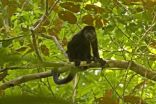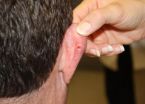(Press-News.org) URBANA -- Events that take place early in life almost certainly have consequences for later cognitive development. Establishing the connections is difficult, however, because human infants cannot be used as laboratory subjects.
Rodney Johnson and his collaborators have developed an alternative model for studying infant brain development. "Assistant professor Ryan Dilger and I became interested in establishing the neonatal piglet as a model of human brain and cognitive development 3 or 4 years ago," he said.
The idea came to Johnson when a former student, who was working for an infant formula company, asked about finding ways to determine differences in cognitive development between breast-fed infants and infants fed on formula.
"Human breast milk is the gold standard, but not every infant can be breast fed. A major goal for many infant formula companies is to improve the formulation to capture all of the benefits of breast milk," he explained.
Johnson and his group had been working with rodent models to study learning and memory; they also had done some research looking at infectious disease in pigs. They wondered if it would be possible to develop tests to look at learning and memory using neonatal piglets.
It seemed like a reasonable idea because the growth and development of the piglet brain is similar to that of the human brain. The brain growth spurt is a perinatal event in both humans and pigs. At birth, the human brain is about 25 percent of adult size. In the first 2 years of life, it reaches 85 to 90 percent of adult size. The piglet brain grows in a similar way in a shorter time.
Johnson's team first developed structural MRI methods for quantifying brain volume in the neonatal piglet. They then used these techniques to determine total brain and brain region volumes in a cohort of male and female domestic pigs, taking repeated measurements every 4 weeks starting at 2 weeks of age and finishing at near sexual maturity at 24 weeks of age.
They found that at 4 weeks, the piglet brain had grown to approximately 50 percent of its maximum volume, and it continued to grow rapidly for the next 8 weeks. Human infant brains grow in a similar way in the postnatal period. The results suggested that environmental insults during this period could affect brain structure and function.
The researchers' next task was to develop a test to assess the piglets' learning and memory, using a T-maze. They thought that this would be easy. They were wrong.
"It actually turned out to be very complicated because there were a lot of things that went wrong that we didn't predict," said Johnson. "For example, when we first started these studies, we used things like Skittles and apple slices as a reward because that's what people using older pigs had done."
The piglets, which were being fed on infant formula, had no interest in solid food, nor were they motivated to perform the tasks if the reward was the same as their regular food. They were, however, very willing to work for chocolate milk, specifically Nesquik™.
They did not receive the Nesquik™ anywhere else. "The idea is that piglets see chocolate milk only during the test and then it's back to the standard formula," said Johnson. "It helps increase their precision because it's something they look forward to."
Tests were conducted in a plus-shaped maze with one arm blocked off to leave a 'T' shape. Piglets were trained to locate the milk reward in a constant place in space as well as direction, using visual cues from outside the maze. When they learned to perform the task correctly the reward location was reversed, and the piglets were retested to assess learning and working memory. Correct choices decreased in the reversal phase but improved over time.
The results demonstrate that the T-maze can be used to measure cognitive abilities. Johnson and his collaborators will use these new tests to examine how stressors such as nutrient deficiencies and infections affect the human brain during this time of early, rapid growth.
"We want to know if this will alter the trajectory of normal development in a way that makes them more susceptible to behavioral disorders that occur later in life, such as autism and depression," Johnson said. "Exposure to environmental insults early in life may also reduce stress resilience," he added.
"There is a lot of interest in the concept of programming, the notion that things that occur early in life set that individual up for problems that occur many years later," he continued. "Because the pig brain grows so much like a human brain, we thought this could be a very attractive model."
The researchers have used the piglet model to demonstrate that an iron-deficient diet causes iron depletion in specific brain areas and is accompanied by cognitive deficits. They are using structural MRI and the T-maze task to study how viral pneumonia in the early neonatal period affects brain and cognitive development.
These data are complemented by measures of neuroinflammation, neurogenesis, and neuron morphology, procedures Johnson's group has established in the neonatal piglet. Ryan Dilger is developing novel MRI procedures to measure biochemicals in the brain and to reveal how neural connections develop.
They are hoping to receive NIH funding to look at maternal viral infections. "We will infect pregnant gilts at the beginning of what would be the third trimester in humans and then study brain and cognitive development in the offspring," Johnson said. "This is the type of interesting question we can pursue now that the piglet model is in place."
Johnson said that it would be difficult to do this kind of research anywhere else.
"The Beckman Institute has been wonderful. We're not MRI experts, nor do we want to be. However, we had a hypothesis and thought MRI technology could help us address it," he said. "The support staff at Beckman has been really critical to helping develop the protocols."
Johnson said that the other major advantages of the U of I are that the College of Agricultural, Consumer and Environmental Sciences has a unique research facility for housing pigs, and the Department of Animal Sciences maintains several swine farms that produce piglets on a regular basis.
###The most recent research has been published online in Developmental Neuroscience.
The research is described in more detail in the following articles:
Conrad, M.S., R.N. Dilger and R.W. Johnson. 2012. "Brain growth of the Domestic Pig (Sus scrofa) from 2 to 24 weeks of Age: A Longitudinal MRI Study." Developmental Neuroscience (in press, online first).
Elmore, M.R.P., R.N. Dilger, R.W. Johnson. 2012. "Place and Direction Learning in a Spatial T-maze test." Animal Cognition 15:667-676.
Conrad, M.S., R.N. Dilger, A. Nickolls, and R.W. Johnson. 2012. "Magnetic Resonance Imaging of the Neonatal Piglet Brain." Pediatric Research 71:179.
Piglets in mazes provide insights into human cognitive development
2012-07-26
ELSE PRESS RELEASES FROM THIS DATE:
Texas A&M biologists prove ZOLOFT packs potential to fight fungal meningitis
2012-07-26
New research conducted by biologists at Texas A&M University suggests that ZOLOFT®, one of the most widely prescribed antidepressants in the world, also packs a potential preventative bonus — potent mechanisms capable of inhibiting deadly fungal infections.
The findings are the result of a two-year investigation by Xiaorong Lin, assistant professor of biology, and Matthew S. Sachs, professor of biology, involving sertraline hydrocholoride (ZOLOFT) and its effects on Cryptococcus neoformans, the major causative agent of fungal meningitis — specifically, cryptococcal meningitis, ...
Increasing dopamine in brain's frontal cortex decreases impulsive tendency, UCSF-Gallo study finds
2012-07-26
Raising levels of the neurotransmitter dopamine in the frontal cortex of the brain significantly decreased impulsivity in healthy adults, in a study conducted by researchers at the Ernest Gallo Clinic and Research Center at the University of California, San Francisco.
"Impulsivity is a risk factor for addiction to many substances, and it has been suggested that people with lower dopamine levels in the frontal cortex tend to be more impulsive," said lead author Andrew Kayser, PhD, an investigator at Gallo and an assistant professor of neurology at UCSF. "We wanted to ...
Tropical arks reach tipping point
2012-07-26
Almost half of the tropical forest reserves in a new study are ineffective, according to results published in the journal Nature by William Laurance, research associate at the Smithsonian Tropical Research Institute now at James Cook University in Australia and more than 200 co-authors.
"Biodiversity is declining rapidly at reserves including Kahuzi Biega in the Democratic Republic of Congo, Xishuangbanna in southern China, and Northern Sierra Madre in the Philippines, among others," said Laurance. "Reserves that are doing relatively well include Bwindi Impenetrable N.P. ...
Researchers find new gene mutation associated with congenital myopathy
2012-07-26
Ann Arbor, Mich. — University of Michigan researchers have discovered a new cause of congenital myopathy: a mutation in a previously uncharacterized gene, according to research published this month in the American Journal of Human Genetics.
About 50% of congenital myopathy cases currently do not have a known genetic basis, presenting a clear barrier to understanding disease and developing therapy, says James Dowling, M.D., Ph.D., the paper's co-senior author and assistant professor of Pediatric Neurology at the University of Michigan's C.S. Mott Children's Hospital. Finding ...
Basal cell carcinoma risk can be chronic
2012-07-26
PROVIDENCE, R.I. [Brown University] — In the powerful sunlight of July, newly published results from a large study of people at high risk for basal cell carcinoma support the emerging view of the nation's most common cancer as a chronic ailment that often repeatedly afflicts older people but for which the seeds may be planted in youth. The research also found a new association with eczema.
"Basal cell carcinoma is a chronic disease once people have had multiple instances of it, because they are always at risk of getting more," said Dr. Martin Weinstock, professor of dermatology ...
High blood sugar, obesity increase risk for surgical site infection
2012-07-26
Two recent studies in the July issues of the Journal of Bone and Joint Surgery (JBJS) looked at surgical site infections and hyperglycemia, the technical term for high blood glucose, or high blood sugar. According to the first study "Relationship of Hyperglycemia and Surgical-Site Infection in Orthopaedic Surgery," high blood sugar is a concern during the post-traumatic and post-operative period and it may help to preoperatively identify a population of patients with musculoskeletal injuries who are at significant risk for infectious complications.
Nearly, one-third ...
Sum of the parts? How our brains see men as people and women as body parts
2012-07-26
When casting our eyes upon an object, our brains either perceive it in its entirety or as a collection of its parts. Consider, for instance, photo mosaics consisting of hundreds of tiny pictures that when arranged a certain way form a larger overall image: In fact, it takes two separate mental functions to see the mosaic from both perspectives.
A new study suggests that these two distinct cognitive processes also are in play with our basic physical perceptions of men and women -- and, importantly, provides clues as to why women are often the targets of sexual objectification.
The ...
Alpine Fault study shows new evidence for regular magnitude 8 earthquakes
2012-07-26
RENO, Nev. – A new study published in the prestigious journal Science, co-authored by University of Nevada, Reno's Glenn Biasi and colleagues at GNS Science in New Zealand, finds that very large earthquakes have been occurring relatively regularly on the Alpine Fault along the southwest coastline of New Zealand for at least 8,000 years.
The Alpine Fault is the most hazardous fault on the South Island of New Zealand, and about 80 miles northwest of the South Island's main city of Christchurch.
The team developed evidence for 22 earthquakes at the Hokuri Creek site, ...
ACR: Medical imaging study in health affairs incomplete and potentially misleading
2012-07-26
In response to a study published in the August issue of Health Affairs regarding declining medical imaging use in recent years, the American College of Radiology (ACR) released a statement explaining that physician education efforts and quality assurance steps have resulted in more efficient use of imaging, but that arbitrary Medicare cuts are damaging patient access to care. The ACR also cited a December 2011 Health Affairs article that shows Medicare imaging cuts may have resulted in physical harm to patients.
"This Health Affairs study further supports the fact that ...
Disabled Pakistani women abandoned, ignored after quake
2012-07-26
(Edmonton) Women who suffered spinal injuries in the 2005 Pakistan earthquake continued to endure hardships years later, including abandonment by spouses and families, according to new research from the University of Alberta.
Zubia Mumtaz, an assistant professor in the School of Public Health who studies how gender and class inequalities affect maternal health, worked with a team of graduate students to document the experiences of paraplegic women three years after the 7.6-magnitude quake that devastated Kashmir. They found that women—far more than men with similar spinal ...



